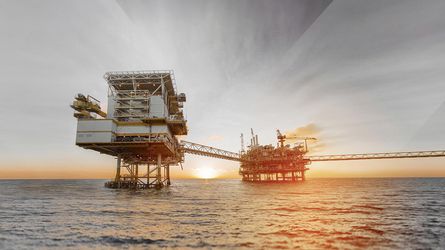
Oil & Gas
You can rely on 60 years of experience in the construction of pumps, packages, skids, and systems for onshore and offshore oil and gas production. Take a look at the information now!
Read more
The NIKKISO centrifugal canned motor pump is an ideal solution for transfer and circulation tasks in the chemical industry. It can be used to pump hazardous, toxic and supercritical fluids.
The stator has a two-layer structure, consisting of the stator liner, stator band, and extremely tight terminal strip, allowing for a higher degree of safety. With the pressure raised by the impeller, the liquid is sent to the discharge side. A part of the fluid also reaches the motor and is used to lubricate the bearings and cool the motor of the centrifugal canned motor pump. Then, this part is lead back through the extraction openings on the shaft (standard model) for the intake side.
The NIKKISO Non-Seal is a compact centrifugal canned motor pump with integrated motor that covers high-pressure and high-temperature applications.
Directly integrating the canned motor into the centrifugal pump does not only ensure environmental protection, but also safety at the plant. All parts of the pump are also designed for easy and fast maintenance. Therefore, you can minimize unproductive down times.
Due to the integrated structure of the centrifugal canned motor pump, it only needs very little space and is ideal for applications in which a small footprint is required.
NIKKISO centrifugal canned motor pumps meet the dimensions and nominal outputs in accordance with DIN EN ISO 2858. This means that NIKKISO fulfills the requirements of a standardized chemical pump, which makes it easier to exchange existing pumps.
The NIKKISO Non-Seal centrifugal canned motor pump is available in Standard and Engineered Design.
| Standard Design | Engineered Design | |
|---|---|---|
| Flow rate max.: | 780m³/h (3430 gpm) | 1200 m³/h (5280 gpm) |
| Pump head max.: | 210m (688ft) | 600 m (1,970 ft) |
| Fluid temperature range | -50 to 350°C (-58 to 662°F) | -200 to 450 °C (-328 to 842 °F) |
| Density range | 0.3 to 2.0 | Max. 13.6 |
| Viscosity max. | 200 mPa∙s (200 cP) | 500 mPa∙s (500cP) |
| Working pressure max. | 4 MPa (600 psig) | 80 MPa (11,600 psig) |
| Liquid end material | SUS316, SUS304 | Alloy 20, Hastelloy C/B, titanium, zirconium, etc. |
| Motor power range | 0.4 to 132 kW (0.5 to 177 metric horsepower) | 200 to 250 kW (268 to 335 metric horsepower) |
| * "Hastelloy" is a registered trademark of Haynes International, Inc. |
We provide different pump models for different applications. Here, the spectrum ranges from all-purpose variants to special designs for high temperatures, pressures or aggressive fluids.
Basic (N) The pump and motor are connected by an adapter plate or a FB housing. A portion of the liquid being pumped is taken from the impeller outlet part of the pump chamber into the rotor chamber for the purposes of cooling the motor and lubricating the bearings. Then, the fluid is returned to the pump chamber through the hollow shaft. A cooling jacket may be fitted to the outer wall of the stator assembly depending on the temperature and other characteristics of the liquid being pumped. | |
Circulation Boost Basic (V) The cross-sectional dimensions are the same as those of the basic design (N type), but the return passage is wider to maintain a return flow of liquid when handling high-viscosity (80 to 200 mPas) liquids. | |
High temperatures (T) Pump and motor are connected with an adapter. The adapter separates the pump thermally from the motor and prevents heat transfer from the pump to the motor. In the design for high temperatures, an independent circulating system is provided for motor cooling and bearing lubrication. Circulation is effected by the auxiliary impeller located at the front end of the rotor chamber. A heat exchanger is fitted to the outer wall of the stator assembly to cool the circulation liquid. | |
High temperatures, without cooling (HX) The HX type is intended for pumping liquids with high temperatures. Cooling is not required when using a special ceramic motor insulation. The HX type can be installed with a heating jacket and is well suited for handling high melting point liquids (above 140 °C) which exceed the temperature limit of normal organic motor insulation materials. | |
Slurry handling (S) The basic construction is identical to that of the pump version for high temperatures. The function of this arrangement is to prevent the slurry handled from entering into the rotor chamber. Clean liquid compatible with the liquid that is pumped is flushed from the inlet port on the rear of the motor to prevent slurry from entering into the rotor chamber. Normally, a backflushing line would be required for this. | |
Mechanical seal when handling slurry (M) A design is also available with a mechanical seal between the pump and motor due to the requirement of decreasing the amount of liquid used for backflushing. This pump type is called a slurry handling pump with a mechanical seal (M type). The backflushing volume can be decreased to 100 ml/day to 500 ml/day. | |
Slurry handling, gas seal (LG) A gas seal type is also available that is suitable for handling heavily corrosive liquids, liquids liable to polymerize or liquids with a high concentration of slurry. The construction is nearly identical to that of the slurry handling pump with mechanical seal listed above. The special feature of this pump type is that a gas chamber is located between the pump unit and the motor unit. The gas chamber separates the pump unit from the motor unit completely. This prevents the risk that the mechanical seal wears out or corrodes through the pumped liquid. Like the backflushing liquid (100 ml/day to 500 ml/day), clean original liquid or clean liquid can be mixed with the pumped liquid if only a very small amount is used. Also, because gas collects in the gas seal chamber, for example, air can be used on nitrogen. | |
High melting point (B) This pump has a construction suitable for liquids with a high solidifying point. It is provided with a heating jacket on the outer face of the pump and the motor to prevent liquid from solidifying at a time of the liquid filling and during the pump operation. | |
Liquid recirculation (Q) The notable feature for this pump is that the circulation line does not form a closed circuit. The coolant for motor and bearings flows through the rotor chamber and is fed back through the outlet of the rear bearing housing at the rear of the motor to the suction tank. With the basic model of the centrifugal canned motor pump (N), a liquid with a low boiling point would evaporate after passing through the rotor chamber due to temperature increase and cause a cavitation. | |
Self-priming pump, horizontal (DN) The underlying structure is identical to the basic design. This pump type is designed so that the pump is self-priming even without a flap valve present. Since there is no flap valve, heavily corrosive liquid can also be handled; in addition, there is no possibility of poor self-priming due to a blockage in the flap valve. | |
Low flow rate; higher head and high speed (HK) The HK type is designed for handling easily evaporating fluid without additional reverse circulation line piping. This pump can maintain higher pressure than the vapor pressure in the motor chamber, thereby preventing evaporation. If you would like to find out more about the HK pump type, please contact us. | |
Multistage Efficient operations in high head applications. |
 Best partner for best solutions LEWA GmbH (DE)
Best partner for best solutions LEWA GmbH (DE) Nikkiso Group Corporate Profile (JP)
Nikkiso Group Corporate Profile (JP) Nikkiso Group Corporate Profile (EN)
Nikkiso Group Corporate Profile (EN) Nikkiso 集团公司简介 (CN)
Nikkiso 集团公司简介 (CN) NIKKISO Non Seal Pumps (USA)
NIKKISO Non Seal Pumps (USA) Best partner for best solutions LEWA Pumpen AG (CH)
Best partner for best solutions LEWA Pumpen AG (CH) NIKKISO Non Seal Pump (ES)
NIKKISO Non Seal Pump (ES) Best Partner for best solutions (IT)
Best Partner for best solutions (IT) NIKKISO Non Seal Pumps (EN)
NIKKISO Non Seal Pumps (EN) NIKKISO Non Seal Pumpe (DE)
NIKKISO Non Seal Pumpe (DE) NIKKISO Non Seal Pump (PT)
NIKKISO Non Seal Pump (PT) NIKKISO Non-Seal centrifugal canned motor pump DIN ISO 2858 (EN)
NIKKISO Non-Seal centrifugal canned motor pump DIN ISO 2858 (EN) NIKKISO Non-Seal Spaltrohrmotorpumpe DIN ISO 2858 (DE)
NIKKISO Non-Seal Spaltrohrmotorpumpe DIN ISO 2858 (DE) NIKKISO Non-Seal Pumps (ES)
NIKKISO Non-Seal Pumps (ES)  Герметичные электронасосы НИККИСО (RU)
Герметичные электронасосы НИККИСО (RU)